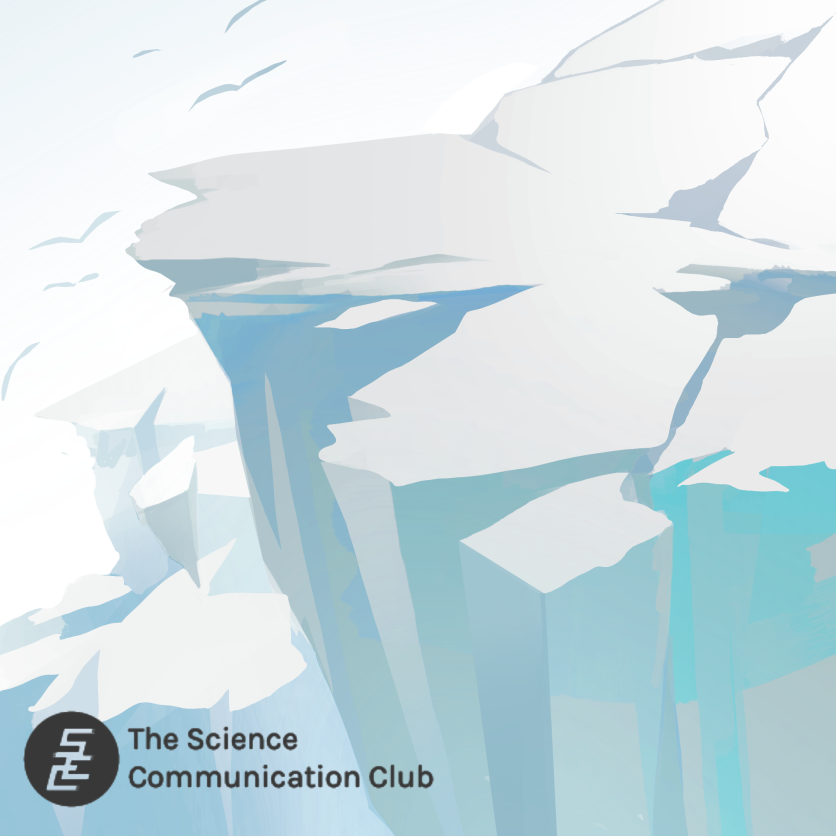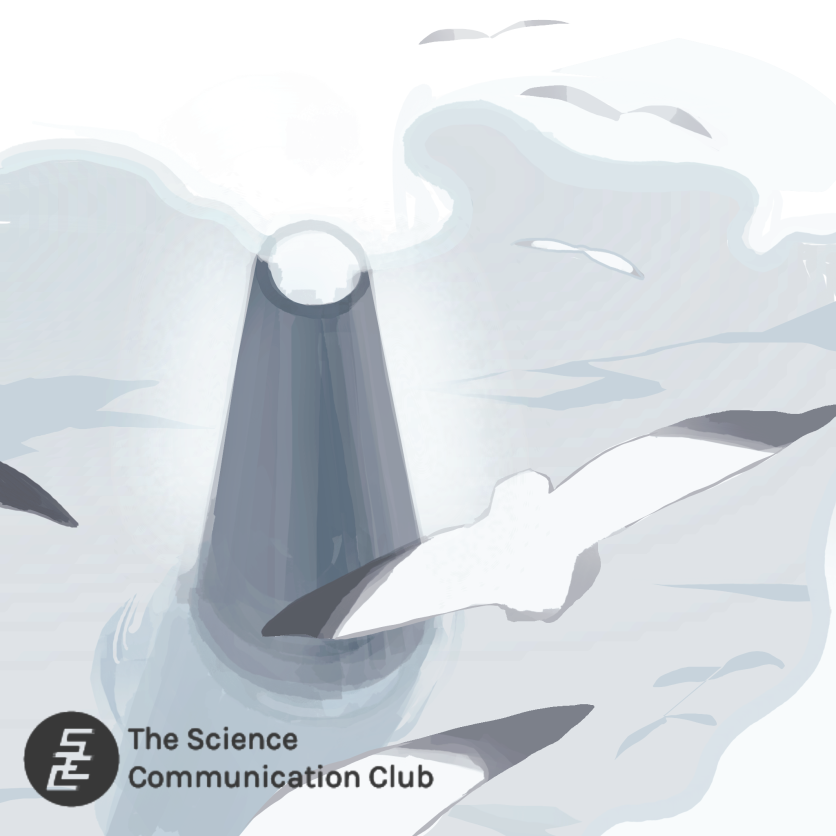
Written by Eda Sagnak
Illustrated by Jasmine Fu
Climate change has been one of the most important yet controversial conversations of our lifetime. Today, we will delve into an important aspect of this topic: glaciers and geoengineering. First, let’s take a look into the role of glaciers in climate change.
One aspect of climate change that is a big concern is the melting of glaciers and seawater levels rising as a result. It is estimated that rising sea levels will lead to the relocation of millions of people living near coastal areas in the next 100 years.1 Can you guess how many people might be affected by a 2-meter increase in Guangzhou, China? (Answer: 2 million) 1
When we think of glaciers, the first thing that pops up into our head are Antarctica and Greenland. However, as much as they are certainly important contributors to the rising sea levels, often overlooked are glaciers outside of these areas such as on mountains. Mountain glaciers are more than just ice collected from low temperatures, they are actually ice sheets that remained there from the ice age that can grow and shrink with seasonal snow and melting.2 These sheets can raise the water levels by 0.4 meters if all of them were to melt.3
Glacier melting occurs due to the elevated temperatures caused by increasing amount of greenhouse gases released by humans, which trap the energy absorbed from the sun inside the atmosphere.4 The importance of mountain glaciers becomes apparent when considering the consequences of their disappearance. Beyond relocation from rising sea levels, communities living near these glaciers may lose an important water source to their rivers.5 In the worst scenario, this may lead to severe water scarcity, forcing them to rely on rainwater for supply, even in very hot seasons.5 To mitigate these effects, geoengineers are exploring solutions like aerosol injections to slow down glacier melting and combat human-caused climate change.
Aerosols are tiny particles suspended in the air, often invisible to the naked eye, that accumulate in the stratosphere and can have various effects on the climate, persisting in the atmosphere for extended periods.6 Geoengineers are exploring the use of aerosols to mitigate the rising sea levels by creating a cooling effect. This effect is achieved by reflecting a portion of the incoming solar radiation, thereby helping to stabilize global temperatures.7 An intriguing aspect of geoengineering research involves modeling these aerosol injections into the stratosphere under different climate scenarios known as Representative Concentration Pathways (RCPs).8

In a ground-breaking study by Zhao et al. (2017), researchers explored the use of stratospheric sulfate aerosol injections to mitigate glacier melting in high-mountain Asia (HMA). These injections, aimed at reducing radiative forcing, could help preserve glaciers by lowering summer temperatures.8 The study compared two geoengineering scenarios injecting sulfate aerosols either as needed (G3) or continuously (G4) into the stratosphere under an RCP scenario.8 The simulation ran for a 50-year period from 2020 to 2069, followed by 20 years of observing the geoengineering effects.8 Overall, while G3 successfully kept average temperatures from rising during the geoengineering period, it only slowed glacier shrinkage by about 50% compared to losses projected.8 On the other hand, G4 (continuous aerosol injections) proved to be a more efficient approach long term.8 Importantly, despite the efforts to stabilize temperatures, the study concluded that Earth is still projected to lose about one-third of its glaciers. This highlights the severity of the climate crisis and the need for urgent action. While geoengineering shows promise in mitigating some of the effects of climate change, it is not a magic wand solution to all our problems. Instead, the study emphasizes the importance of reducing greenhouse gas emissions and implementing sustainable practices to address the root causes of climate change.
Another study by Moore et al. (2023) explored the use of stratospheric sulfate aerosol injections, but this time, to mitigate glacier melting in Greenland. Running simulations, authors found that they could significantly reduce ice loss from the Greenland ice sheet.9 Specifically, implementing the G4 plan (continuous aerosol injections) could reduce mass loss by 31%–38% by 2090, relative to projections.9 This reduction is crucial for mitigating global sea-level rise, for which Greenland’s ice sheet is a primary contributor.
Despite promising avenues stemming from geoengineering, both studies emphasized that aerosol injections into the stratosphere will merely allow us to buy time until we can address the root issues behind climate change. Moreover, aerosol injections also have their downsides, they may potentially trigger severe weather changes, affect the distribution of infectious diseases and, being gases, they are unpredictable.10 Overall, nothing that we add onto nature comes without its side effects, and it is essential to weigh the advantages against disadvantages before implementing any method. We live in a crucial time, when making predictions based on accurate research may be our most essential tool in our battle against climate change. I would like to state, much like the authors from both studies, that this article merely wishes to inform of new advances in this area while adopting a neutral stance on the political, social, and economic factors surrounding climate change. As we navigate these complex challenges, we must tread carefully, considering the broader impact that science may have on our planet and society.
Sources:
1. Moore JC, Gladstone R, Zwinger T, Wolovick M. Geoengineer polar glaciers to slow sea-level rise. Nature. 2018;555(7696):303–305. doi:10.1038/d41586-018-03036-4
2. Lindsey R. Climate Change: Mountain Glaciers. Climate.gov. 2020 Feb 14. https://www.climate.gov/news-features/understanding-climate/climate-change-mountain-glaciers
3. Zemp M, Huss M, Thibert E, Eckert N, McNabb R, Huber J, Barandun M, Machguth H, Nussbaumer SU, Gärtner-Roer I, et al. Global glacier mass changes and their contributions to sea-level rise from 1961 to 2016. Nature. 2019;568(7752):382–386. doi:10.1038/s41586-019-1071-0
4. Climate change: the greenhouse gases causing global warming. Topics European Parliament. 2023 Mar 23. https://www.europarl.europa.eu/topics/en/article/20230316STO77629/climate-change-the-greenhouse-gases-causing-global-warming
5. FAQ 2.1: How does glacier shrinkage affect river runoff further downhill? IPCC. https://www.ipcc.ch/srocc/about/faq/faq-chapter-2/#:~:text=Rising%20temperatures%20cause%20mountain%20glaciers,lose%20a%20valuable%20water%20source.
6. Chen A, Howl B, Sidel A. Aerosols and Their Importance. NASA Earth Sciences, Goddard Earth Sciences Division Projects. 2015. https://earth.gsfc.nasa.gov/climate/data/deep-blue/aerosols#:~:text=Sea%20spray%2C%20mineral%20dust%2C%20smoke,from%20volcanoes%20or%20industrial%20emissions.
7. Keys PW, Barnes EA, Diffenbaugh NS, Hurrell JW, Bell CM. Potential for perceived failure of stratospheric aerosol injection deployment. Proceedings of the National Academy of Sciences. 2022;119(40):e2210036119. doi:10.1073/pnas.2210036119
8. Zhao L, Yang Y, Cheng W, Ji D, Moore JC. Glacier evolution in high-mountain Asia under stratospheric sulfate aerosol injection geoengineering. Atmospheric Chemistry and Physics. 2017;17(11):6547–6564. doi:10.5194/acp-17-6547-2017
9. Moore JC, Greve R, Yue C, Zwinger T, Gillet‐Chaulet F, Zhao L. Reduced Ice Loss From Greenland Under Stratospheric Aerosol Injection. Journal of Geophysical Research: Earth Surface. 2023;128(11):e2023JF007112. doi:10.1029/2023JF007112
10. Solar radiation management – risks from reversing climate change. Swiss Re Institute. 2023 Jun 14. https://www.swissre.com/institute/research/sonar/sonar2023/solar-radiation-risks-climate-change.html